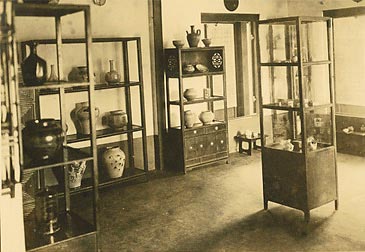
Soetsu Yanagi (1889-1961) about 1954.
History of the Japan Folk Crafts Museum and Founder Soetsu Yanagi
Soetsu Yanagi, known as first advocator of the Mingei Movement, was born in Tokyo in 1889. He took part in the launch of the magazine ‘Shirakaba’ in 1910 and actively worked as a central member of the Shirakaba literary school. Then he began to take a deep interest in arts and the philosophy of religion.
In 1914, Yanagi encountered ceramics of Joseon Dynasty introduced by Asakawa Noritaka and Takumi brothers. Triggered by this, Yanagi got attracted to the peculiar beauty of form and shape Joseon people produced. In 1924, Yanagi founded the Korean Folk Art Museum (‘Korean Folk-arts Gallery’ in Yanagi’s English) in Seoul.
Later, Yanagi came to pay attention to his own country, Japan. The first thing which attracted Yanagi’s eye was a folk Buddha in Edo period called Mokujiki sculpture. As Yanagi traveled various areas in Japan to investigate folk Buddha, he was gradually paying attention to the healthy and the honest beauty which he found in ordinary people’s craftworks made by unknown craftspeople.

display of the Korean Folk Art Museum in 1924.
It was 1925 when Yanagi, together with potter Kanjiro Kawai and Shoji Hamada, coined the term ‘Mingei’ literally meaning ‘folk crafts’ or ‘common crafts’. In the following year, he announced a prospectus for the formation of a museum of folk crafts and started in earnest the movement to establish a museum.
While Yanagi devoted himself in promoting the Mingei philosophy and introducing various handicrafts from all over Japan, The Japan Folk Crafts Museum was finally founded in 1936 and Yanagi became first president of the museum. Based on the museum, Yanagi engaged in various activities, such as traveling to Tohoku, Kyushu or Okinawa to investigate and collect craftworks, holding exhibitions of Joseon craftworks or Otsu-e, introducing craftworks of Ainu and Taiwan tribes, proposing the reform of tea ceremony and advocating Buddhist aesthetics based on the thoughts of Tariki Hongan (the power of the Original Vow made by Amida Buddha).

the museum under construction, 1936.
The Main Hall was designed by Soetsu Yanagi himself, and the old wing and the stone wall along the street were designated as Tokyo Metropolitan Government Designated Tangible Cultural Property (Building) in 2021. It is wooden building using Oya-stone. With an intention to present the museum hall itself as one of the beauty of creation, Yanagi himself involved in the design of not only outside appearance but also fittings inside. To make objects appear most beautiful, there adapted various ingenuities in the way to show. For example, kudzu-cloth has been used for specially ordered wooden showcases and wallpaper. This clearly suggests that Yanagi paid a close attention to exhibitions.